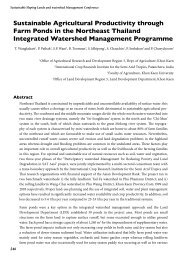Cross-border NTFP value chains Laos – China - nafri
Cross-border NTFP value chains Laos – China - nafri
Cross-border NTFP value chains Laos – China - nafri
Create successful ePaper yourself
Turn your PDF publications into a flip-book with our unique Google optimized e-Paper software.
Results obtained from studying the relationship between tree size and resin production<br />
demonstrate that small trees are likely to produce less benzoin than larger trees. Trees<br />
having a dbh less than 13 cm were found to be unsuitable for tapping. There was no<br />
direct comparison of the resin yield in relation to bark thickness of the tree. However,<br />
given that bark thickness is correlated positively with tree diameter, it would be<br />
reasonable to assume that trees with thick bark are likely to produce more benzoin than<br />
those with thin bark. The results, however, did not support the popular claim by villagers<br />
that benzoin yield is greater at higher tapping positions on the tree. The tapping results,<br />
however, do confirm that more benzoin is produced at higher (but not the highest)<br />
positions on the stem. But the results raise more questions than answers. It was<br />
expected that the lower portion of the stem would produce more benzoin because the<br />
diameter is larger, and bark is thicker and rougher than the upper portion. This aspect of<br />
benzoin production is worthy of further investigation. In addition, it is also recommended<br />
to conduct further studies as the overall productivity of the trees in the experimental<br />
plots was extremely poor when compared to that observed for the trees tapped by<br />
villagers in adjacent areas.<br />
The tapping experiments demonstrated clear differences among the 3 tapping methods.<br />
All 3 methods showed satisfactory results in terms of resin production with the<br />
traditional Lao method as the most suitable one. However, it was not possible, to<br />
determine the optimal tapping method among them as other factors, such as the time<br />
required to tap and ease of application, were not assessed. It is recommended that<br />
testing of the Indonesian, V-shaped and Lao A methods be repeated, taking into<br />
account such factors. Also, if sustainable yield from styrax trees is to be achieved, it is<br />
necessary to study the optimal number of tapping cuts per tree which do not cause<br />
serious harm to the trees and yet assure that tapping can continue for successive<br />
seasons.<br />
The orientation aspect of the tapping cuts on the tree may influence yield, due to the<br />
effects of sunlight and leafiness of the tree. One side of the tree may be leafier than<br />
another and the exposure down-slope may be different from the exposure up-slope.<br />
These site factors of individual trees may influence their resin production and should be<br />
examined in any further trials.<br />
In the trials, it was also observed that cutting of the undergrowth vegetation below the<br />
styrax trees may reduced overall resin yield as the tapping cuts dry out because of<br />
exposure to direct sunlight and heat. However, the trial data of both years (1999 and<br />
2000) did not support the assumption that undergrowth has a significant influence on<br />
the capacity of trees to exude benzoin. The differences between individual trees might<br />
be more important.<br />
Trying to stimulate sap flow by beating the bark around the tapping cut has no<br />
significant influence on the benzoin production.<br />
16



